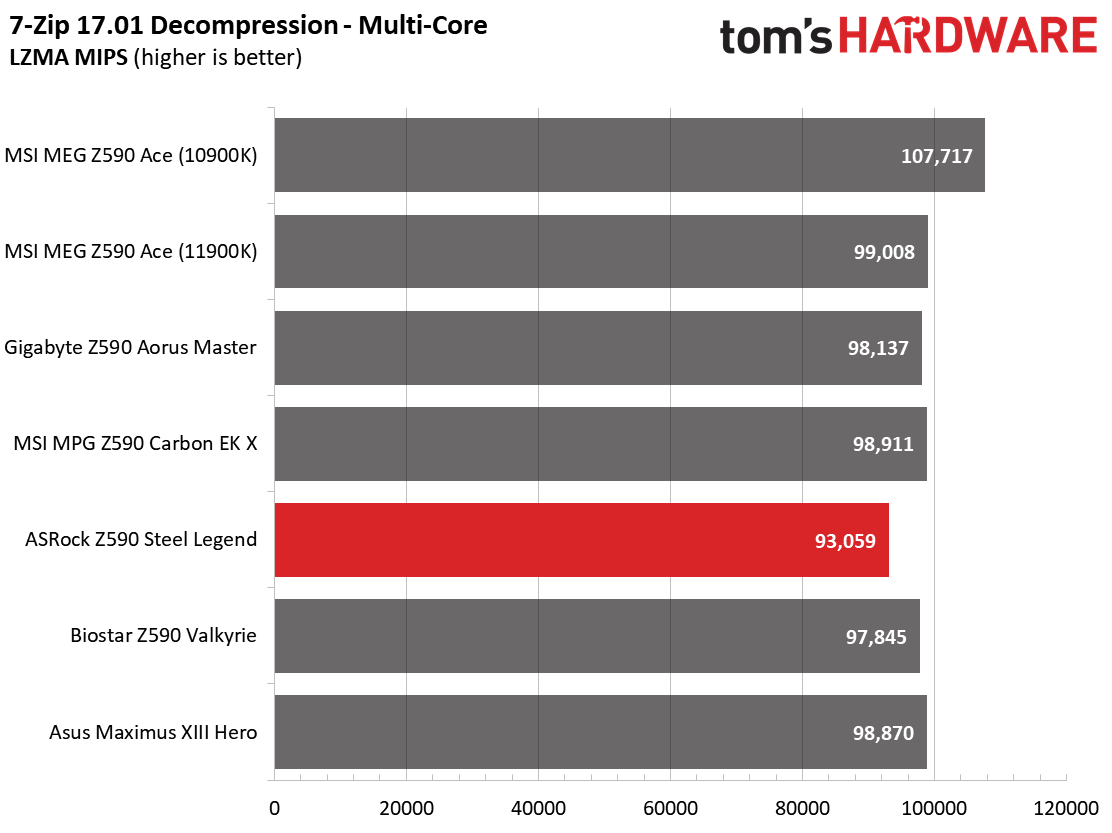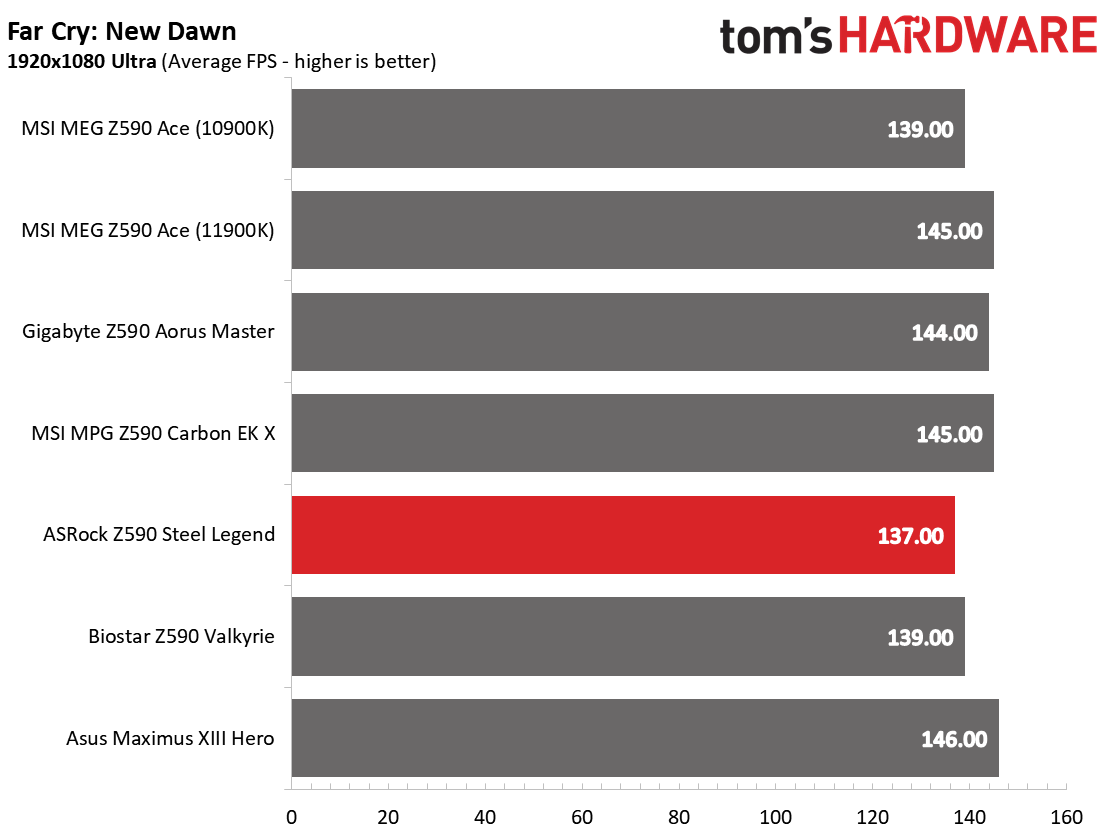Why you can trust Tom's Hardware
Benchmark Results
Our standard benchmarks and power tests are performed using the CPU’s stock frequencies (including stock Thermal Velocity Boost), with all power-saving features enabled. Optimized defaults are set in the BIOS and the memory set using the XMP profiles. For this baseline testing, Windows is set to the balanced power plan.
Synthetic Benchmarks
Synthetics are a great tool to figure out if a board runs out of spec, as identical settings should produce similar performance results. Advanced memory timings are the one place where motherboard makers can still optimize for either stability or performance, though, and those settings can impact some testing.





















In the synthetic benchmarks, the Steel Legend held its own in shorter tests and the PCMark 10 suite, allowing the CPU to boost freely and not get capped by turbo time/power limits.
Note that if there are any performance shortcomings due to this motherboard following Intel specifications, all you need to do is raise the Turbo Power and time limits, and it behaves like any other board that doesn’t follow spec.
Timed Applications



LAME testing shows the Steel Legend in the middle of the pack, while the longer-running Corona benchmark puts this board at the back of the pack, a full four seconds behind the next slowest time. Handbrake results were also the slowest we’ve tested so far. Between the stock Intel specs and the memory running in gear 2 at 3600 MHz (where other boards were 1:1) the board was a lot slower.
3D Games and 3DMark




We’ve recently updated our game tests to F1 2020 and Far Cry: New Dawn. The games run at 1920x1080 resolution using the Ultra preset. As the resolution goes up, the CPU tends to have less of an impact. The goal with these settings is to determine if there are differences in performance at the most commonly used resolution with settings most people use or at least strive for.
For our gaming tests, we saw tremendous gains moving from the RTX 2070 to an RTX 3070. For 3DMark Fire Strike and Time Spy, the Steel Legend results are similar among tested boards, including against an i9-10900K. In F1 2020, the system averaged 208 frames per second (FPS). Far Cry: New Dawn results were slightly lower than the rest at 137 FPS--most other results were in the mid-140 range.
Power Consumption / VRM Temperatures
For power testing, we used AIDA64’s System Stability Test with Stress CPU, FPU and Cache enabled, using the peak power consumption value. With Rocket Lake, we need to disable AVX-512 instruction sets . Otherwise, temperatures are out of control at stock speeds on some boards. The wattage reading is from the wall via a Kill-A-Watt meter to capture the entire ecosystem. The only variable that changes is the motherboard; all other parts are the same.
Get Tom's Hardware's best news and in-depth reviews, straight to your inbox.
Starting with idle power, the Asrock Z590 Steel Legend WiFi 6E consumed 59W from the wall, which is on the lower side of results thus far. Load wattage peaked at 257W, the lowest recorded value when using the i9-11900K. When averaged out, that comes to 158W, the lowest we’ve tested so far, if only slightly. You’d never notice the difference in your power bill, but it’s good to know this board uses a bit less power.




The VRM on the Steel Legend isn’t the most robust, with its 14 50A MOSFETs. That said, it is still plenty capable of driving both 10th and 11th Generation CPUs without issue at both stock and while overclocked. During stock operation, it was the coolest running of all air-cooled motherboards. If you look at the CPU temperature during the turbo window, it peaks at almost 90 degrees Celsius, then drops back down to the upper 50s and low 60s.
Once we remove the shackles and overclock, the Steel Legend’s VRMs heat up and temps peak at almost 70 degrees Celsius. While this is hot, the hottest we’ve tested so far, the 50A Vishay power MOSFETs ran well within operating parameters.
Overclocking
When overclocking the i9-11900K, we decided to do so by testing without AVX-512 instructions. When you unlock all of the power limits, you’re thermally limited with the CPU reaching 100 degrees Celsius in several seconds. Since every board is different from how they follow (or not follow) Intel specifications, we’ve removed that variable. The bottom line is that if you need to use these instructions, you’ll need to set a significant offset compared to non-AVX-512 loads. So with that decision made, we settled on a 5.1 GHz overclock at around 1.3V. Our CPU uses around 225W in this configuration, which lands between stock power use (195W) and AVX-512 power use (~265W), which is the end of the line due to thermal constraints.
As we saw above, the VRM is plenty capable of supporting an overclocked i9-11900K. It just runs a bit hot while doing so. We used a higher LLC level to stabilize the difference between idle and load voltage, but this is common, especially on boards that do not have the most robust power delivery.
Using the latest BIOS (when this was published), we saw average results out of the box with Reads, Writes, and Copy metrics blending seamlessly with the other results. Latency was slightly higher than most boards, at 56.6 ns, where others are in the mid to upper 40s. This was due in part to the Steel Legend’s using 1:2 gearing for DDR4 3600 (more on Rocket Lake’s memory gears here). We tried briefly to use Gear 1. However, the board wouldn’t play nice with these sticks. We tried our DDR4 4000 kit during our overclocking testing and could not stabilize things at that speed. Perhaps a BIOS update down the road will allow for a 1:1 ratio and additional compatibility, as most other boards default to 1:1 at DDR4 3600 and work with the same RAM kit.
Final Thoughts
Starting with performance, the ASRock Z590 Steel Legend WiFi 6E out of the box was a little slower on average than some other boards, particularly in long-running tests where the Intel Turbo boost kicks in and lowers clocks. If you raise the power limits, removing these restrictions, the board more closely matches its peers’ performance out of the box.
Outside of capable power delivery, ASRock’s Z590 Steel Legend includes the latest Wi-Fi 6E capabilities using an Intel Wi-Fi 6E AX210 card. Just note that to utilize the 6E portion, you will need a 6E-capable router such as the Asus ROG Rapture GT-AXE11000 or the Netgear Nighthawk RAXE500. The motherboard also includes 2.5 GbE on the wired side, a theme you’ll often see on the Z590 platform.
On the storage front, with the addition of more and faster PCIe lanes, we’ll see more boards with up to three M.2 sockets, and the Z590 Steel Legend is no different. There are three M.2 sockets for storage, with one PCIe 4.0 x4 (64 Gbps) slot and two PCIe 3.0 x3 (32 Gbps). Add that to the six SATA ports and your storage needs should be covered. The rear IO has six USB ports, but users could be left wanting more. I’d like to see eight back here. That said, there are additional headers to provide more, including a front-panel USB 3.2 Gen2x2 Type-C port (another feature you’ll see on most Z590-based boards).
On the style/appearance front, the Z590 Steel Legend makes iterative improvements, hanging on to the same general patterns and color schemes. The black/white/grey with RGB accents should fit in with most build themes but still looks part of a budget board. As a value-add, ASRock includes a GPU card holder that attaches to the motherboard and chassis to support heavy graphics cards. Typically you find something like this included with cases or high-end video cards, but it’s nice to see with a motherboard.
The biggest drawback with the Z590 Steel Legend is its inclusion of just six USB ports on the rear IO. You can of course add more via headers. Many Z590 motherboards stepped up to the new Realtek audio codec, however this inexpensive model uses an older codec. I would like to see a 1200 series codec used, even at this price point. Another concern, though minor, is that in our testing the board runs our DDR4 3600 memory kit at 1:2 ratio, increasing latency. Most boards (not all) we’ve tested so far run the memory at 1:1 at that speed by default. That said, this is a new platform with a new CPU, so you can expect teething issues, and improvements there may come via BIOS updates.
When writing, the Z590 Steel Legend is the least-expensive Z590 motherboard listed on Newegg. That said, there are only seven boards in total available currently. By price, somewhere around the $200-$250 range, MSI’s Z590 Pro WiFI, Gigabyte’s Aorus Elite Gaming X, Asus’ Prime TUF Gaming Z590-Plus, and Biostar’s Racing Z590GTA are all direct competitors at the budget end of the Z590 realm.
For the most part, all of these boards have up to two or M.2 sockets and six SATA ports, so the difference is found within the price point and appearance. ASRock’s Steel Legend is priced well for Z590, just barely breaking the $200 mark. It comes with enough basics and features that it is one of the better options for getting into the Z590 platform without spending a lot.
MORE: Best Motherboards
MORE: How To Choose A Motherboard
MORE: All Motherboard Content

Joe Shields is a staff writer at Tom’s Hardware. He reviews motherboards and PC components.


